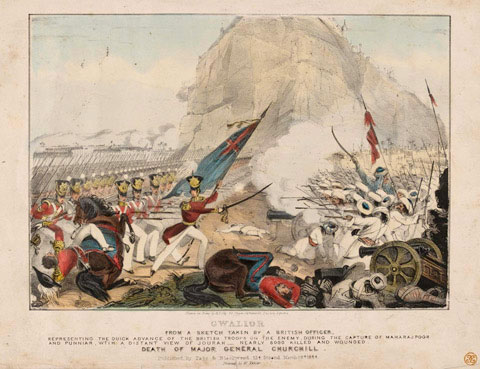The Gwalior campaign was fought between the British and Maratha forces in Gwalior in India, in December 1843.
Background of Gwalior Campaign
The Maratha Empire once held sway over much of central and northern India. However, in 1818, it surrendered to the British, granting them control over virtually the entire Indian subcontinent.
Following the death of the Maharaja of Gwalior, a young child was appointed his successor with British backing. However, the Marathas in Gwalior saw an opportunity to regain independence after the British failure of Britishers in their campaign in Afghanistan, and they expelled the young Maharaja.
Lord Ellenborough, anticipating the possibility of the Marathas in Gwalior seeking autonomy, established the Army of Exercise near Agra. When attempts to negotiate failed, the British launched a two-pronged attack. On December 29, 1843, the British, led by Gen. Sir Hugh Gough, clashed with Maratha forces, commanded by Maharaja Scindia, in two battles on the same day.
Battle of Maharajpore
At the Battle of Maharajpore, the Maratha army had a formidable force of 14 battalions, 1,000 artillerymen equipped with 60 guns, and 6,000 cavalries.
Meanwhile, the British army comprised the 40th Regiment of Foot and the 2nd and 16th Native Infantry Regiments in the central column, the 39th Regiment of Foot, the 56th Native Infantry Regiment, and a field battery in the left column, and the 16th Lancers with two troops of horse artillery and other artillery in the right column.
Originally, the central column moved forward to attack what they believed was the primary enemy force. However, the Marathas had shifted their positions during the night, catching the British off-guard as they faced heavy fire from the Maratha artillery. The central column then received orders to seize the battery positions, which they accomplished despite being under continuous and heavy fire from the enemy.
The Maratha guns were located to the southeast of Maharajpore, with two battalions guarding each battery, while seven battalions were stationed in Maharajpore.
The ensuing hand-to-hand combat was fierce, with both sides incurring heavy casualties. Nevertheless, the British army succeeded, and the Marathas suffered a significant loss, with an estimated 3,000 to 4,000 men killed.
The British army faced a considerable loss of 797 soldiers killed, wounded, or missing. Despite the challenging battle, the British appeared victorious in the end.
Battle of Punniar
On 29 December 1843, at Punniar, the Maratha army had a force of approximately 12,000 soldiers and had taken up positions on the elevated terrain close to Mangore. However, upon the arrival of the British Army, they promptly launched an assault on the Maratha positions, successfully forcing them to retreat from the hill.
Aftermath of Gwalior Campaign
Following the Maratha forces’ defeat in Gwalior, the British dismantled their army and formed a new force under the Gwalior government’s control. Additionally, a British governor was designated to oversee operations at Gwalior Fort.
Soldiers from the British contingent who took part in the campaign were granted the Gwalior Star medal as a recognition of their service.
>Read about First Anglo Maratha War, Second Anglo-Maratha War

